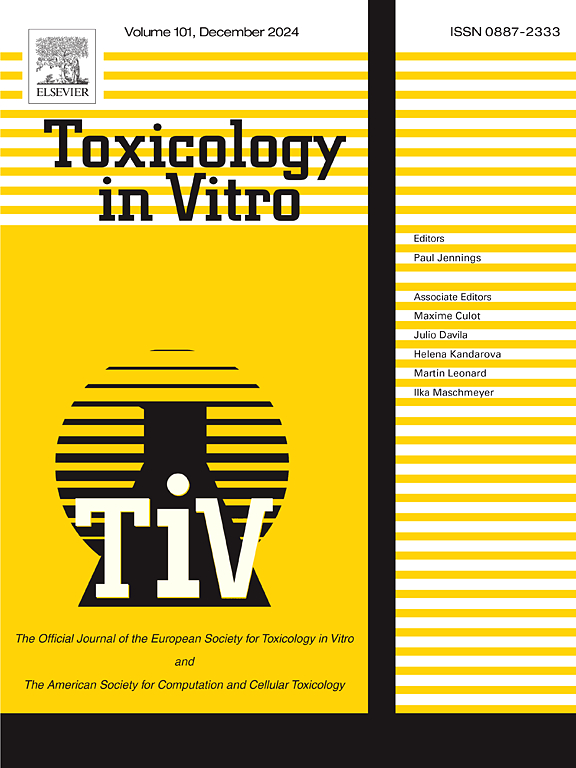有机溶剂对三种OATP异构体体外转运活性的影响。
IF 2.6
3区 医学
Q3 TOXICOLOGY
引用次数: 0
摘要
目的:转运体活性的体外研究通常需要添加有机溶剂,如二甲基亚砜(DMSO)、甲醇和乙醇,以溶解底物和/或抑制剂。虽然这可能会减弱转运活性,但不同类型的有机溶剂对转运蛋白活性的影响尚未阐明。本研究旨在定量评估有机溶剂对有机阴离子转运多肽(OATP) 1B1、1A2和2B1转运活性的影响。方法:采用表达OATP蛋白的HEK293细胞,评估DMSO、甲醇和乙醇对OATP1A2、OATP2B1或OATP1B1介导的[3H]雌酮3-硫酸酯(DCF)摄取的浓度依赖性影响,并计算使摄取减少20% % (IC20)的浓度。结果与讨论:甲醇和乙醇对ooatp的吸收活性有浓度依赖性,IC20值分别为2.4 ~ 3.4 %和0.51 ~ 3.8 %。相比之下,DMSO在DMSO的最大浓度(10 %)下不影响oatp2b1介导的摄取,而对OATP1B1和1A2表现出浓度依赖性的抑制作用,IC20值分别约为3 %和0.7 %。本研究为体外评价oops活性的实验条件提供了有用的信息。本文章由计算机程序翻译,如有差异,请以英文原文为准。
The effect of organic solvents on the in vitro transport activity of three OATP isoforms
Purpose
In vitro studies of transporter activity often require the addition of organic solvents such as dimethyl sulfoxide (DMSO), methanol, and ethanol, to dissolve substrates and/or inhibitors. Although this may attenuate the transport activity, the influence of different types of organic solvents on transporter activity has not been elucidated. This study aimed to quantitatively assess the impact of organic solvents on the transport activity of organic anion transporting polypeptide (OATP) 1B1, 1A2, and 2B1.
Methods
The concentration-dependent influence of DMSO, methanol, and ethanol on the uptake of [3H]estrone 3-sulfate mediated by OATP1A2, OATP2B1 or 2′,7′-dichlorofluorescein (DCF) mediated by OATP1B1 was assessed using HEK293 cells expressed the respective OATP protein and the concentration that reduced the uptake by 20 % (IC20) was calculated.
Results and discussion
The uptake activities of OATPs were reduced by methanol and ethanol in a concentration-dependent manner, with IC20 values of 2.4–3.4 % and 0.51–3.8 % respectively. In contrast, DMSO did not affect the OATP2B1-mediated uptake at the maximum concentration (10 %) of DMSO whereas it exhibited concentration-dependent inhibition for OATP1B1 and 1A2 with IC20 values of approximately 3 % and 0.7 %, respectively. This study provides useful information regarding experimental conditions for evaluating OATPs activity in vitro.
求助全文
通过发布文献求助,成功后即可免费获取论文全文。
去求助
来源期刊

Toxicology in Vitro
医学-毒理学
CiteScore
6.50
自引率
3.10%
发文量
181
审稿时长
65 days
期刊介绍:
Toxicology in Vitro publishes original research papers and reviews on the application and use of in vitro systems for assessing or predicting the toxic effects of chemicals and elucidating their mechanisms of action. These in vitro techniques include utilizing cell or tissue cultures, isolated cells, tissue slices, subcellular fractions, transgenic cell cultures, and cells from transgenic organisms, as well as in silico modelling. The Journal will focus on investigations that involve the development and validation of new in vitro methods, e.g. for prediction of toxic effects based on traditional and in silico modelling; on the use of methods in high-throughput toxicology and pharmacology; elucidation of mechanisms of toxic action; the application of genomics, transcriptomics and proteomics in toxicology, as well as on comparative studies that characterise the relationship between in vitro and in vivo findings. The Journal strongly encourages the submission of manuscripts that focus on the development of in vitro methods, their practical applications and regulatory use (e.g. in the areas of food components cosmetics, pharmaceuticals, pesticides, and industrial chemicals). Toxicology in Vitro discourages papers that record reporting on toxicological effects from materials, such as plant extracts or herbal medicines, that have not been chemically characterized.
 求助内容:
求助内容: 应助结果提醒方式:
应助结果提醒方式:


